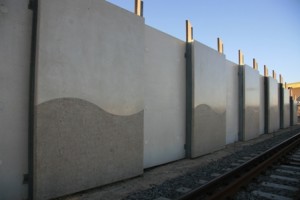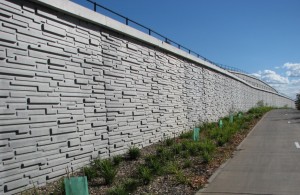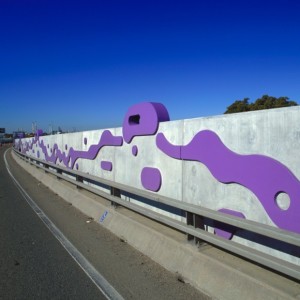Noise walls (also known as acoustic, sound or noise barriers) are precast concrete elements that are designed to inhibit the transmission of sound waves. There are 3 basic types (all of which can be manufactured with a variety of finishes).
Reflective Barriers
Generally are placed at the road edge to reflect traffic noise. Some sound still passes over the barrier but there is a reduction in overall noise level behind the barrier. Reflective barriers are typically higher than other types.
Dispersive Barriers
These disperse the noise upwards and/or downwards due to their inclination and surface pattern. They are often considered to be a variation of the reflective barrier.
Absorptive Barriers
Sound is absorbed and dissipated by sound wave pressure moving through a carefully designed membrane or passage. These barriers generally use a propriety system for the sound absorption. Generally they are not effective for wide easements.
Click here for Noise Walls product profile
Advantages
- Superior structural outcome
- Quality product
- Off-site manufacture means high quality
- Durable
- High strength, factory produced, long life precast concrete offers the ultimate outcome with minimal maintenance
- High load capacity
- Reduction in formwork and propping
- A sustainable solution
- Significant sustainability advantages through de-materialisation
- Faster construction time
- Quick installation by highly skilled crews
- Less weather dependent
- Simplified and safer construction process
- Less trades on site
- Less exposure to OHS and industrial relations risks
- Less waste
- Less materials handling
- High quality surface finishes.Alternatavly, noise walls can be made using Glass Reinforced Concrete (GRC) – find out more about GRC here.
Applications
- Roadways
- Railways
- Bridges
- Shopping Centres
- Parking structures
- Tunnels
- Airports
- Stadiums







